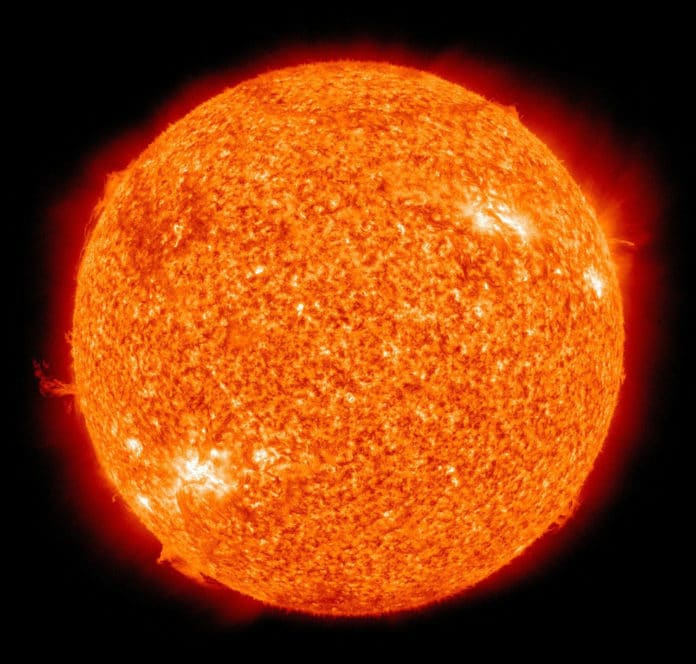In 1960, astronomers discovered Sun’s high musical notes, i.e., Sun rings like a bell. Millions of acoustic oscillations with short periods, near 5 minutes, are excited by convective turbulence near the solar surface and are trapped in the solar interior.
These 5-minute oscillations have been observed continuously by ground-based telescopes and space observatories since the mid-1990s. Helioseismologists use these oscillations to get knowledge on the internal structure and dynamics of the Sun. One of the triumphs of helioseismology is to have mapped the Sun’s rotation as a function of depth and latitude.
It was also predicted that much longer-period oscillations exist, but they are not discovered yet. The long-period oscillations depend on the Sun’s rotation; they are not acoustic.
The detection of long-period oscillations requires measurements of the horizontal motions at the Sun’s surface over many years. The continuous observations from the Helioseismic and Magnetic Imager (HMI) onboard SDO are perfect for this purpose.
Now, a team of solar physicists led by Laurent Gizon of the Max Planck Institute for Solar System Research (MPS) and the University of Göttingen in Germany has discovered global oscillations with very long periods, comparable to the 27-day solar rotation period.
The oscillations show themselves at the solar surface as whirling movements with speeds on the request for 5 kilometers each hour. These motions were estimated by analyzing ten years of observations from NASA’s Solar Dynamics Observatory (SDO).
Using computer models, scientists found that the newly discovered oscillations are resonant modes and owe their existence to the Sun’s differential rotation.
Scientists observed many tens of modes of oscillation, each with its oscillation period and spatial dependence. Some oscillation modes have a maximum velocity at the poles, some at mid-latitudes, and some near the equator.
Zhi-Chao Liang from MPS said, “The long-period oscillations manifest themselves as very slow swirling motions at the surface of the Sun with speeds of about 5 kilometers per hour—about how fast a person walks.”
MPS graduate student Yuto Bekki said, “To identify the nature of these oscillations, we compared the observational data to computer models. The models allow us to look inside the Sun’s interior and determine the full three-dimensional structure of the oscillations.”
The east-west velocity is associated with the retrograde propagating mode of oscillation. Left: observations using the SDO/HMI instrument. Right: a numerical model. Sound: filtered data (86 ± 10 nHz) shifted to the audible spectrum; the sound variations inform us about the excitation and damping of the mode. © MPS/ Z-C Liang
The group started with a model of the Sun’s structure and differential rotation induced from helioseismology to obtain the model oscillations. Moreover, the strength of the convective driving in the upper layers and the amplitude of turbulent motions are represented in the model.
The free oscillations of the model are found by considering small-amplitude perturbations to the solar model. The corresponding velocities at the surface are a good match to the observed oscillations and enabled the team to identify the modes.
The east-west velocity associated with the retrograde propagating mode of oscillation. Left: observations using the SDO/HMI instrument. Right: numerical model. Sound: filtered data (73 ± 10 nHz) shifted to the audible spectrum; the sound variations inform us about the excitation and damping of the mode. © MPS/ Z-C Liang
MPS scientist Damien Fournier said, “All of these new oscillations we observe on the Sun are strongly affected by the Sun’s differential rotation. The dependence of the solar rotation with latitude determines where the modes have maximum amplitudes.”
Robert Cameron from MPS said, “The oscillations are also sensitive to properties of the Sun’s interior: in particular to the strength of the turbulent motions and the related viscosity of the solar medium, as well as to the strength of the convective driving. This sensitivity is strong at the base of the convection zone, about two hundred thousand kilometers beneath the solar surface.”
“Just like we are using acoustic oscillations to learn about the sound speed in the solar interior with helioseismology, we can use the long-period oscillations to learn about the turbulent processes.”
The north-south velocity is associated with the retrograde propagating mode of oscillation. Left: observations using the SDO/HMI instrument. Right: a numerical model. Sound: filtered data (269 ± 10 nHz) shifted to the audible spectrum; the sound variations inform us about the excitation and damping of the mode. © MPS/ Z-C Liang
Laurent Gizon said, “The discovery of a new type of solar oscillations is fascinating because it allows us to infer properties, such as the strength of the convective driving, which ultimately control the solar dynamo. The diagnostic potential of the long-period modes will be fully realized in the coming years using a new exascale computer model being developed as part of the project WHOLESUN, supported by a European Research Council 2018 Synergy Grant.”
Journal Reference:
- Laurent Gizon et al., Solar inertial modes: Observations, identification, and diagnostic promise, Astronomy & Astrophysics (2021) DOI: 10.1051/0004-6361/202141462
